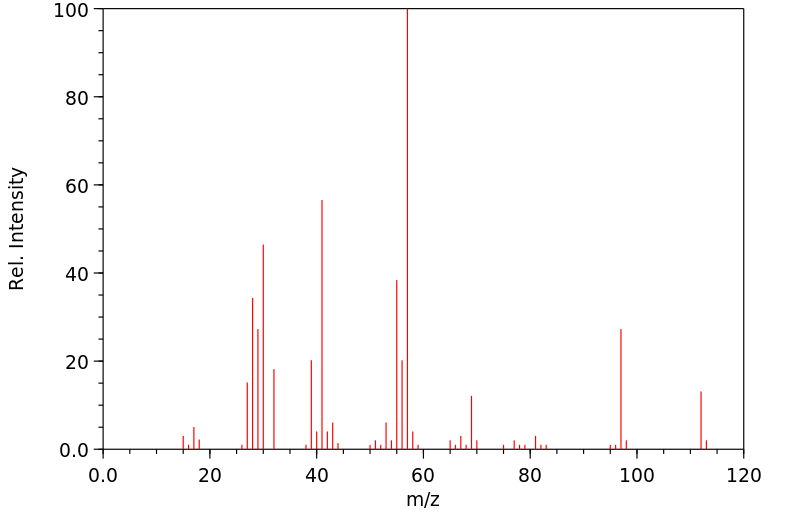2,2,4-三甲基-4-硝基戊烷 | 5342-78-9
分子结构分类
中文名称
2,2,4-三甲基-4-硝基戊烷
中文别名
2,2,4-三甲基-1,3-戊二醇二异丁酸酯
英文名称
2,2,4-trimethyl-4-nitro-pentane
英文别名
2,2,4-Trimethyl-4-nitro-pentan;2,2,4-Trimethyl-4-nitropentane
CAS
5342-78-9
化学式
C8H17NO2
mdl
——
分子量
159.228
InChiKey
CUEFTLGHWYSCTO-UHFFFAOYSA-N
BEILSTEIN
——
EINECS
——
-
物化性质
-
计算性质
-
ADMET
-
安全信息
-
SDS
-
制备方法与用途
-
上下游信息
-
文献信息
-
表征谱图
-
同类化合物
-
相关功能分类
-
相关结构分类
物化性质
-
熔点:23.5-23.7 °C
-
沸点:100.4 °C(Press: 34.5 Torr)
-
密度:0.9394 g/cm3
计算性质
-
辛醇/水分配系数(LogP):2.7
-
重原子数:11
-
可旋转键数:2
-
环数:0.0
-
sp3杂化的碳原子比例:1.0
-
拓扑面积:45.8
-
氢给体数:0
-
氢受体数:2
安全信息
-
海关编码:2904209090
SDS
上下游信息
-
上游原料
中文名称 英文名称 CAS号 化学式 分子量 2,2,4-三甲基-4-亚硝基戊烷 2,2,4-tetramethyl-4-nitrosopentane 31044-98-1 C8H17NO 143.229 -
下游产品
中文名称 英文名称 CAS号 化学式 分子量 —— N-tert-octylhydroxylamine 98544-91-3 C8H19NO 145.245
反应信息
-
作为反应物:描述:参考文献:名称:脂肪族硝基化合物的脱氮加氢和脂肪族硝基化合物作为自由基前体的新用途摘要:在氢化三丁基锡氢化物处理中,脂肪族硝基被氢取代,氢化三丁基锡通过自由基链过程进行。由于硝基被选择性地反硝化并且其他可还原基团不受氢化三丁基锡的影响,因此该反应可用作从多官能化合物中去除硝基的方法。通过脱硝产生的自由基中间体也可用于碳-碳键形成反应。DOI:10.1016/s0040-4020(01)97180-7
-
作为产物:描述:参考文献:名称:Nametkin; Sabrodina, Doklady Akademii Nauk SSSR, 1950, vol. 75, p. 395,543, 701摘要:DOI:
文献信息
-
Thermischer zerfall von β-phenyl- und β,β-diphenyl- nitroalkanen作者:Katharina Fritzsche、Hans-Dieter Beckhaus、Christoph RüchardtDOI:10.1016/0040-4039(88)85215-8日期:1988.1Elimination of nitrous acid is the exclusive reaction path for the thermal decomposition of the nitroalkanes 1, 2 and 5. Homolytic CC-cleavage cannot compete. A concerted β-elimination is the favoured mechanism.消除亚硝酸是硝基烷1、2和5热分解的唯一反应途径。均质CC裂解无法竞争。一致的β-消除是最受青睐的机制。
-
FORMATION OF QUATERNARY CARBON CENTERS FROM TERTIARY NITRO COMPOUNDS BY FREE RADICAL METHODS作者:Noboru Ono、Hideyoshi Miyake、Aritsune KajiDOI:10.1246/cl.1985.635日期:1985.5.5The radical intermediates generated by denitration of tertiary nitro compounds with tributyltin hydride undergo the carbon–carbon bond forming reaction with double bonds, which provides a useful method for the construction of quaternary carbon centers.
-
A new synthetic method: Direct replacement of the nitro group by hydrogen or deuterium作者:Noboru Ono、Hideyoshi Miyake、Rui Tamura、Aritsune KajiDOI:10.1016/s0040-4039(01)90417-4日期:1981.1The nitro group in tertiary or secondary aliphatic nitro compounds is replaced by hydrogen or deuterium on treatment with tributyltin hydride or tributyltin deuteride, respectively.
-
The c-alkylation of nitroalkame anions by l-substituted-2--butyl-4-phenyl- and -2,4-diphenyl-5,6-dihydrobenzo(ulbarh]quinolinium cations作者:Alan R. Katritzky、M. Akram Kashmiri、Dieter K. WittmannDOI:10.1016/s0040-4020(01)91797-1日期:1984.1- The N-substituents are transferred from the title cations to the C-atom of nitroalkane anions in high yield at 25-80°C in DMSO solution. The title cations are readily available from the appropriate pyrylium cations and primary amines of types RCH2,NH2, and RR'CHNH2, allowing a general 2-step method for the preparation of higher nitro- alkanes. Spectral properties of a variety of nitroalkanes are
-
NITRATED HYDROCARBONS AND DERIVATIVES申请人:ANGUS CHEMICAL COMPANY公开号:EP3121162A1公开(公告)日:2017-01-25A compound selected from the group consisting of formula I-1, II-1, III-1 and IV-1: or a compound selected from the group consisting of: 2-(hydroxylamino)hexane, 3-(hydroxylamino)hexane, 2-(hydroxylamino)octane, and 3-(hydroxylamino)octane, wherein: R7 and R9 are independently linear C2-C17 alkyl; R11 is an unsubstituted linear C2-C17 alkyl; R8 is H or linear C1-C8 alkyl; R10 and R14 are independently H, linear C1-C8 alkyl, or CH2OH, or R9, R10, and the carbon to which they are attached form an eight membered cycloalkyl ring; R12 is H, an unsubstituted linear C1-C8 alkyl, or CH2OH, or R11, R12, and the carbon to which they are attached form a C9-C11 cycloalkyl ring; R13 is C2-C20 alkyl, C3-C12 cycloalkyl, aryl, or aryl-alkyl-; R14 is H or C1-C12 alkyl, or R13 and R14 together with the carbon to which they are attached form a C3-C12 cycloalkyl ring; R15 is H, or R14, R15, and the atoms to which they are attached form an oxazolidine ring that is optionally substituted with C1-C6 alkyl; and R16 is H, C1-C12 alkyl, C3-C12 cycloalkyl, or aryl; provided that: when the compound is selected from formula I-1, the total number of carbons in R7 and R8, together with the carbon to which they are attached, is 10 to 18; and the compound is not 1-nitrodecane, 2-nitrodecane, 1-nitroundecane, 2-nitroundecane, 3-nitroundecane, 4-nitroundecane, 5-nitroundecane, 6-nitroundecane, 1-nitrododecane, 2-nitrododecane, 3-nitrododecane, 4-nitrododecane, 5-nitrododecane, 6-nitrododecane, 1-nitrotridecane, 2-nitrotridecane, 3-nitrotridecane, 6-nitrotridecane, 1-nitrotetradecane, 1-nitropentadecane, 1-nitrohexadecane, 2-nitrohexadecane, 1-nitroheptadecane, 1-nitrooctadecane, or 2-nitrooctadecane; when the compound is selected from formula II-1, if R10 is H or linear C1-C8 alkyl, the total number of carbons in R9 and R10, together with the carbon to which they are attached, is 5 to 18; or if R10 is CH2OH, R9 is linear C12-C16 alkyl; and the compound is not 2-nitro-1-hexanol, 2-nitro-1-heptanol, 2-nitro-1-octanol, 2-methyl-2-nitro-1-heptanol, or 2-nitro-1-dodecanol; when the compound is selected from formula III-1, if R12 is H or linear C1-C8 alkyl, the total number of carbons in R11 and R12, together with the carbon to which they are attached, is 6 to 18; or if R12 is CH2OH, R11 is linear C7-C17 alkyl; and the compound is not 2-amino-1-heptanol, 2-amino-2-methyl-1-hexanol, 2-amino-1-octanol, 2-amino-2-ethyl-1-hexanol, 2-amino-1-nonanol, 2-amino-2-methyl-1-octanol, 2-amino-1-decanol, 2-amino-2-octyl-1,3-propanediol, 2-amino-2-butyl-1-hexanol, 2-amino-1-undecanol, 2-amino-1-dodecanol, 2-amino-2-decyl-1,3-propanediol, 2-amino-1-tridecanol, 2-amino-2-methyl-1-dodecanol, 2-amino-1-tetradecanol, 2-amino-2-dodecyl-1,3-propanediol, 2-amino-2-methyl-1-tridecanol, 2-amino-1-pentadecanol, 2-amino-2-tridecyl-1,3-propanediol, 2-amino-1-hexadecanol, 2-amino-2-tetradecyl-1,3-propanediol, 2-amino-2-methyl-1-pentadecanol, 2-amino-2-hexyl-1-decanol, 2-amino-1-heptadecanol, 2-amino-2-pentadecyl-1,3-propanediol, 2-amino-1-octadecanol, or 2-amino-2-hexadecyl-1,3-propanediol; and when the compound is selected from formula IV-1, if R13 is an ethyl group, R14 is not H; and the compound is not 5-propyl-1-aza-3,7-dioxabicyclo[3.3.0]octane, 4,4-diethyl-1-oxa-3-azacyclopentane, 3-oxa-1-azaspiro[4.4]nonane, 3-oxa-1-azaspiro[4.5]decane, or 3-oxa-1-azaspiro[4.7]dodecane.从式 I-1、II-1、III-1 和 IV-1 所组成的组中选出的化合物: 或选自以下组别的化合物2-(羟基氨基)己烷、3-(羟基氨基)己烷、2-(羟基氨基)辛烷和 3-(羟基氨基)辛烷,其中:R7 和 R9 独立地是线性 C2-C17 烷基;R11 是未取代的线性 C2-C17 烷基;R8 是 H 或线性 C1-C8 烷基;R10 和 R14 独立地是 H、线性 C1-C8 烷基或 CH2OH,或 R9、R10 和它们所连接的碳形成八位环烷基环;R12 是 H、未取代的线性 C1-C8 烷基或 CH2OH,或 R11、R12 和它们所连接的碳形成 C9-C11 环烷基环;R13 是 C2-C20 烷基、C3-C12 环烷基、芳基或芳基烷基;R14 是 H 或 C1-C12 烷基,或 R13 和 R14 与它们连接的碳一起形成 C3-C12 环烷基环;R15 是 H,或 R14、R15 和它们连接的原子形成任选被 C1-C6 烷基取代的噁唑烷环;以及 R16 是 H、C1-C12 烷基、C3-C12 环烷基或芳基; 条件是当化合物选自式 I-1 时,R7 和 R8 中的碳原子总数连同它们所连接的碳原子数为 10 至 18;且该化合物不是 1-硝基十二烷、2-硝基十二烷、1-硝基十四烷、2-硝基十四烷、3-硝基十四烷、4-硝基十四烷、5-硝基十四烷、6-硝基十四烷、1-硝基十二烷、2-硝基十二烷、3-硝基十二烷、4-硝基十二烷、5-硝基十二烷6-硝基十二烷、1-硝基十三烷、2-硝基十三烷、3-硝基十三烷、6-硝基十三烷、1-硝基十四烷、1-硝基十五烷、1-硝基十六烷、2-硝基十六烷、1-硝基十七烷、1-硝基十八烷或 2-硝基十八烷;当化合物选自式 II-1 时,如果 R10 是 H 或直链 C1-C8 烷基,则 R9 和 R10 中的碳原子总数连同它们所连接的碳原子数为 5 至 18;或者如果 R10 是 CH2OH,则 R9 是直链 C12-C16 烷基;并且化合物不是 2-硝基-1-己醇、2-硝基-1-庚醇、2-硝基-1-辛醇、2-甲基-2-硝基-1-庚醇或 2-硝基-1-十二烷醇;当化合物选自式 III-1,如果 R12 是 H 或线型 C1-C8 烷基,则 R11 和 R12 中的碳原子总数连同它们所连接的碳原子数为 6 至 18;或者如果 R12 是 CH2OH,则 R11 是线型 C7-C17 烷基;且化合物不是 2-氨基-1-庚醇、2-氨基-2-甲基-1-己醇、2-氨基-1-辛醇、2-氨基-2-乙基-1-己醇、2-氨基-1-壬醇、2-氨基-2-甲基-1-辛醇、2-氨基-1-癸醇、2-氨基-2-辛基-1、3-丙二醇、2-氨基-2-丁基-1-己醇、2-氨基-1-十一醇、2-氨基-1-十二醇、2-氨基-2-癸基-1,3-丙二醇、2-氨基-1-十三醇、2-氨基-2-甲基-1-十二醇、2-氨基-1-十四醇、2-amino-2-dodecyl-1,3-propanediol, 2-amino-2-methyl-1-tridecanol, 2-amino-1-pentadecanol, 2-amino-2-tridecyl-1,3-propanediol, 2-amino-1-hexadecanol, 2-amino-2-tetradecyl-1,3-propanediol、2-amino-2-methyl-1-pentadecanol, 2-amino-2-hexyl-1-decanol, 2-amino-1-heptadecanol, 2-amino-2-pentadecyl-1,3-propanediol, 2-amino-1-octadecanol, 或 2-amino-2-hexadecyl-1,3-propanediol;当化合物选自式 IV-1 时,如果 R13 是乙基,R14 不是 H;且化合物不是 5-丙基-1-氮杂-3,7-二氧杂环[3.3.0]辛烷、4,4-二乙基-1-氧杂-3-氮杂环戊烷、3-氧杂-1-氮杂螺[4.4]壬烷、3-氧杂-1-氮杂螺[4.5]癸烷或 3-氧杂-1-氮杂螺[4.7]十二烷。
表征谱图
-
氢谱1HNMR
-
质谱MS
-
碳谱13CNMR
-
红外IR
-
拉曼Raman
-
峰位数据
-
峰位匹配
-
表征信息
同类化合物
顺式-2-硝基环己基乙酸酯
顺式-2-硝基-6-甲基环己酮
雷尼替丁杂质18
铝硝基甲烷三氯化物
钾离子载体III
重氮(硝基)甲烷
醛基-七聚乙二醇-叠氮
过氧亚甲基
辛腈,4-氟-4-硝基-7-羰基-
辛烷,1,2-二氯-1-硝基-
赤霉素A4+7(GA4:GA7=65:35)
苄哒唑
羟胺-四聚乙二醇-叠氮
羟胺-三乙二醇-叠氮
米索硝唑
磷酸十二醇酯
碘硝基甲烷
碘化e1,1-二甲基-4-羰基-3,5-二(3-苯基-2-亚丙烯基)哌啶正离子
硝酰胺
硝基脲银(I)复合物
硝基甲醇
硝基甲烷-d3
硝基甲烷-13C,d3
硝基甲烷-13C
硝基甲烷-(15)N
硝基甲烷
硝基甲基甲醇胺
硝基环辛烷
硝基环戊烷
硝基环戊基阴离子
硝基环庚烷
硝基环己烷锂盐
硝基环己烷钾盐
硝基环己烷
硝基环丁烷
硝基氨基甲酸
硝基新戊烷
硝基二乙醇胺
硝基乙醛缩二甲醇
硝基乙醛缩二乙醇
硝基乙腈
硝基乙烷-D5
硝基乙烷-1,1-d2
硝基乙烷
硝基乙烯
硝基丙烷
硝基丙二醛(E,E)-二肟
硝基丙二腈
硝基-(3-硝基-[4]吡啶基)-胺
硝乙醛肟







